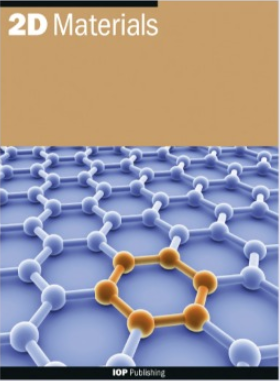Two-dimensional Janus MXTe (M = Hf, Zr; X = S, Se) piezoelectrocatalysts: a comprehensive investigation of its electronic, synthesis feasibility, electric polarization, and hydrogen evolution reaction activity
IF 4.3
3区 材料科学
Q2 MATERIALS SCIENCE, MULTIDISCIPLINARY
引用次数: 0
Abstract
We computationally investigated potential piezoelectrocatalysts, two-dimensional (2D) Janus MXTe (M = Hf, Zr; X = S, Se). The structural and electronic properties, synthesis feasibility, piezoelectric properties, and hydrogen evolution reaction were calculated. Our results showed that these 2D Janus MXTe are narrow-gap semiconductors, indicating great conductivity for electrocatalysis. The feasibility of synthesis was comparable to the already synthesized Janus materials. To exhibit a piezoelectrocatalytic effect, the material has to be piezoelectric and catalytically effective simultaneously. As the Janus structure breaks the centrosymmetry, the considered MXTe are intrinsically piezoelectric. We therefore calculated the dipole moments and the variation of out-of-plane polarization upon strain. The computed piezoelectric coefficient e31 is within the same order of magnitude as that of other Janus 2D materials. Finally, although pristine 2D Janus MXTe were inert to hydrogen evolution reaction, incorporation of single-atom defects was found to boost hydrogen adsorption significantly. The catalytic efficacy can be further tuned by biaxial tensile strain, effectively controlling the Gibbs free energy of adsorption to be close to the thermoneutral value that is indicative of an excellent hydrogen evolution reaction activity, at least for ZrSTe Janus monolayer. In summary, this work proposed and comprehensively investigated a new class of possible piezoelectrocatalysts, 2D Janus materials, which is feasible to be synthesized, catalytically effective, and has great conductivity.二维 Janus MXTe(M = Hf、Zr;X = S、Se)压电催化剂:对其电子、合成可行性、电极化和氢进化反应活性的全面研究
我们通过计算研究了潜在的压电催化剂--二维(2D)Janus MXTe(M = Hf、Zr;X = S、Se)。对其结构和电子特性、合成可行性、压电特性和氢进化反应进行了计算。我们的研究结果表明,这些二维 Janus MXTe 是窄隙半导体,在电催化方面具有很强的导电性。合成的可行性与已合成的 Janus 材料相当。要表现出压电催化效应,材料必须同时具有压电性和催化作用。由于 Janus 结构打破了中心对称性,因此所考虑的 MXTe 本身就是压电材料。因此,我们计算了偶极矩和面外极化在应变时的变化。计算得出的压电系数 e31 与其他 Janus 二维材料的压电系数在同一数量级。最后,尽管原始的二维 Janus MXTe 对氢进化反应是惰性的,但发现单原子缺陷的加入能显著提高氢的吸附能力。双轴拉伸应变可进一步调节催化效率,有效控制吸附的吉布斯自由能,使其接近热中性值,这表明至少 ZrSTe Janus 单层具有出色的氢进化反应活性。总之,本研究提出并全面研究了一类可能的新型压电催化剂--二维 Janus 材料,该材料合成可行、催化有效、导电性强。
本文章由计算机程序翻译,如有差异,请以英文原文为准。
求助全文
约1分钟内获得全文
求助全文
来源期刊

2D Materials
MATERIALS SCIENCE, MULTIDISCIPLINARY-
CiteScore
10.70
自引率
5.50%
发文量
138
审稿时长
1.5 months
期刊介绍:
2D Materials is a multidisciplinary, electronic-only journal devoted to publishing fundamental and applied research of the highest quality and impact covering all aspects of graphene and related two-dimensional materials.
 求助内容:
求助内容: 应助结果提醒方式:
应助结果提醒方式:


